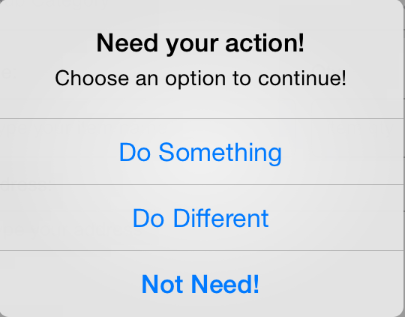Сделать кнопку UIAlertView триггерной функцией при нажатии
В настоящее время я использую следующий код для представления UIAlertView:
UIAlertView *alert = [[UIAlertView alloc] initWithTitle:@"Today's Entry Complete"
message:@"Press OK to submit your data!"
delegate:nil
cancelButtonTitle:@"OK"
otherButtonTitles: nil];
[alert show];
[alert release];
Как сделать так, чтобы при нажатии кнопки " OK " запускалась функция, скажем -(void)submitData
7 ответов:
Примечание:
Важно: UIAlertView устарел в iOS 8. (Обратите внимание, что UIAlertViewDelegate также не рекомендуется.) Для создания и управления оповещениями в iOS 8 и более поздних версиях вместо этого используйте UIAlertController с предпочтительным стилем UIAlertControllerStyleAlert.
Пожалуйста, проверьте этот учебник
Objectvie C
.H file
@interface urViewController : UIViewController <UIAlertViewDelegate> {.m file
// Create Alert and set the delegate to listen events UIAlertView *alert = [[UIAlertView alloc] initWithTitle:@"Today's Entry Complete" message:@"Press OK to submit your data!" delegate:self cancelButtonTitle:nil otherButtonTitles:@"OK", nil]; // Set the tag to alert unique among the other alerts. // So that you can find out later, which alert we are handling alert.tag = 100; [alert show]; //[alert release]; -(void) alertView:(UIAlertView *)alertView clickedButtonAtIndex:(NSInteger)buttonIndex{ // Is this my Alert View? if (alertView.tag == 100) { //Yes // You need to compare 'buttonIndex' & 0 to other value(1,2,3) if u have more buttons. // Then u can check which button was pressed. if (buttonIndex == 0) {// 1st Other Button [self submitData]; } else if (buttonIndex == 1) {// 2nd Other Button } } else { //No // Other Alert View } }Swift
Самый быстрый способ-использовать новый UIAlertController и замыкания:
// Create the alert controller let alertController = UIAlertController(title: "Title", message: "Message", preferredStyle: .Alert) // Create the actions let okAction = UIAlertAction(title: "OK", style: UIAlertActionStyle.Default) { UIAlertAction in NSLog("OK Pressed") } let cancelAction = UIAlertAction(title: "Cancel", style: UIAlertActionStyle.Cancel) { UIAlertAction in NSLog("Cancel Pressed") } // Add the actions alertController.addAction(okAction) alertController.addAction(cancelAction) // Present the controller self.presentViewController(alertController, animated: true, completion: nil)
Если вы используете несколько экземпляров UIAlertView, которые не объявлены в интерфейсе класса, вы также можете установить тег для идентификации экземпляров в методе делегата, например:
Где-то в верхней части файла класса myClass.m
#define myAlertViewsTag 0Создание UIAlertView:
UIAlertView *alert = [[UIAlertView alloc] initWithTitle:@"My Alert" message:@"please press ok or cancel" delegate:self cancelButtonTitle:@"Cancel" otherButtonTitles:@"OK", nil]; alert.tag = myAlertViewsTag; [alert show]; [alert release];Метод делегата:
-(void)alertView:(UIAlertView *)alertView didDismissWithButtonIndex:(NSInteger)buttonIndex { if (alertView.tag == myAlertViewsTag) { if (buttonIndex == 0) { // Do something when cancel pressed } else { // Do something for ok } } else { // Do something with responses from other alertViews } }
Вам нужно задать делегат при выделении alertview, а затем использовать один из методов UIAlertViewDelegate для вызова собственного метода, например:
UIAlertView *alert = [[UIAlertView alloc] initWithTitle:@"Today's Entry Complete" message:@"Press OK to submit your data!" delegate:self cancelButtonTitle:@"OK" otherButtonTitles:nil]; [alert show]; [alert release]; - (void)alertView:(UIAlertView *)alertView didDismissWithButtonIndex:(NSInteger)buttonIndex { [self submitData]; }
Вам нужно настроить
delegateдля вашегоUIAlertView, прежде чем показывать его. Затем выполните работу в обратном вызове делегата как таковой:-(void)alertView:(UIAlertView*)alert didDismissWithButtonIndex:(NSInteger)buttonIndex; { if ([[alert buttonTitleAtIndex] isEqualToString:@"Do it"]) { // Code to execute on Do it button selection. } }Мой проект CWUIKit на https://github.com/Jayway/CWUIKit имеет дополнение к
UIAlertView, которое позволяет делать то же самое, но с блоками. Повторное использование одной и той же операции для создания, отображения и обработки предупреждения об этом:[[UIAlertView alertViewWithTitle:@"My Title" message:@"The Message" cancelButtonTitle:@"Cancel" otherTitlesAndAuxiliaryActions:@"Do it", ^(CWAuxiliaryAction*a) { // Code to execute on Do it button selection. }, nil] show];
Если вы хотите использовать блоки, вы также можете использовать MKAdditions, Чтобы легко достичь этого даже для нескольких UIAlertViews.
Просто используйте код, подобный этому образцу:
[[UIAlertView alertViewWithTitle:@"Test" message:@"Hello World" cancelButtonTitle:@"Dismiss" otherButtonTitles:[NSArray arrayWithObjects:@"First", @"Second", nil] onDismiss:^(int buttonIndex) { NSLog(@"%d", buttonIndex); } onCancel:^() { NSLog(@"Cancelled"); } ] show];Вы можете найти дополнительную информацию в этом руководстве: http://blog.mugunthkumar.com/coding/ios-code-block-based-uialertview-and-uiactionsheet
Еще немного разъяснений,
- (void)alertView:(UIAlertView *)alertView clickedButtonAtIndex:(NSInteger)buttonIndex { //handles title you've added for cancelButtonTitle if(buttonIndex == [alertView cancelButtonIndex]) { //do stuff }else{ //handles titles you've added for otherButtonTitles if(buttonIndex == 1) { // do something else } else if(buttonIndex == 2) { // do different thing } } }Пример,
UIAlertView *alert = [[UIAlertView alloc] initWithTitle:@"Need your action!" message:@"Choose an option to continue!" delegate:self cancelButtonTitle:@"Not Need!" otherButtonTitles:@"Do Something", @"Do Different", nil]; [alert show];
(это скриншот iOS7)
Из iOS8 Apple предоставляет новый класс
UIAlertController, который вы можете использовать вместо UIAlertView, который теперь устарел, его также указано в сообщении об амортизацииUIAlertView устарел. Используйте UIAlertController с предпочтительным стилем из UIAlertControllerStyleAlert вместо
Поэтому вы должны использовать что-то вроде этого
Цель C
UIAlertController * alert = [UIAlertController alertControllerWithTitle:@"Title" message:@"Message" preferredStyle:UIAlertControllerStyleAlert]; UIAlertAction* yesButton = [UIAlertAction actionWithTitle:@"Yes, please" style:UIAlertActionStyleDefault handler:^(UIAlertAction * action) { //Handle your yes please button action here }]; UIAlertAction* noButton = [UIAlertAction actionWithTitle:@"No, thanks" style:UIAlertActionStyleDefault handler:^(UIAlertAction * action) { //Handle no, thanks button }]; [alert addAction:yesButton]; [alert addAction:noButton]; [self presentViewController:alert animated:YES completion:nil];Swift
Самый быстрый способ-использовать новый UIAlertController и закрытие:
// Create the alert controller let alertController = UIAlertController(title: "Title", message: "Message", preferredStyle: .Alert) // Create the actions let okAction = UIAlertAction(title: "OK", style: UIAlertActionStyle.Default) { UIAlertAction in NSLog("OK Pressed") } let cancelAction = UIAlertAction(title: "Cancel", style: UIAlertActionStyle.Cancel) { UIAlertAction in NSLog("Cancel Pressed") } // Add the actions alertController.addAction(okAction) alertController.addAction(cancelAction) // Present the controller self.presentViewController(alertController, animated: true, completion: nil)
